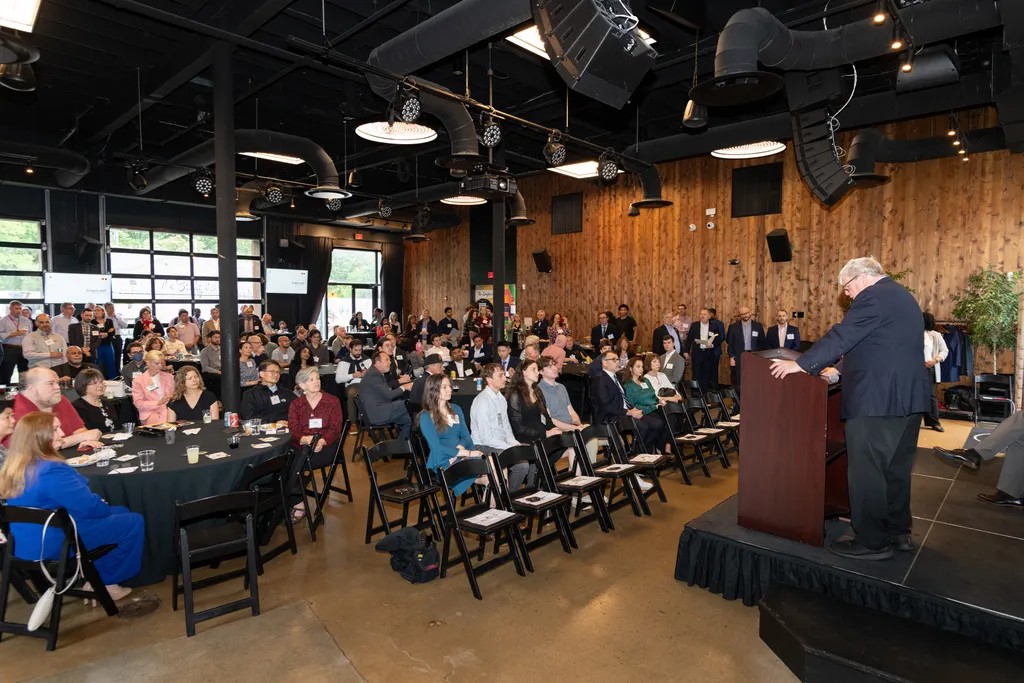- May 14, 2025
- By Jordan Dunklee
What if artificial intelligence could think less like a calculator and more like a brain—quick to adapt, sensitive to change and able to learn without being told how?
A team of University of Maryland researchers have developed a method that can do just that: a new way to train AI to mimic the natural neural rhythms of the human brain. The breakthrough, which the team calls “rhythmic sharing,” has the potential to revolutionize AI systems by enabling them to spot early warning signs in everything from cancer to climate, and it claimed the top honor in the university’s annual Invention of the Year competition.
“This work reimagines what AI can be—learning from the brain to create a truly adaptive and intuitive tool, capable of evolving with remarkable potential for real-world impact,” said physics Professor Wolfgang Losert.
Alongside awardees in three other categories, including a new social innovation category, Losert and co-inventor Hoony Kang Ph.D. ’24 were announced Tuesday as overall Invention of the Year Award winners as part of Innovate Maryland—an annual celebration of UMD researchers’ creativity in translating cutting-edge research into practical, impactful solutions to address global challenges.
“Tonight’s nominees for Invention of the Year are powerful reminders of what’s possible when imagination meets determination,” said Vice President for Research Gregory F. Ball. “They reflect the incredible spirit of innovation that thrives across our research community—a community united by a shared vision to turn bold ideas into lasting impact.”
In addition to the Invention of the Year Awards, three special recognition awards were presented to honor recipients for their exceptional contributions to UMD’s innovation ecosystem and their lasting impact both in the region and beyond.
ION Storage Systems, founded by Distinguished University Professor of materials science and engineering Eric Wachsman, was recognized as Startup of the Year for their pioneering work to develop safer, more powerful and fully recyclable solid-state batteries.
Kan Cao, professor of cell biology and molecular genetics, was named Entrepreneur of the Year for launching Bluelene; the skin care line from her company, MBlue Labs, is the first to harness the anti-aging properties of the antioxidant methylene blue.
Reinhard Radermacher (1952-2025), former director of the Center for Environmental Energy Engineering and Minta Martin Professor of Mechanical Engineering, was honored posthumously for his unparalleled career at UMD as an inventor. He holds the record for most inventions disclosed with a cumulative total of 150 since 1984, was himself an Invention of the Year winner in 2010 and finalist three other times. Six companies further developed and commercialized Radermacher’s technologies over his career at UMD, demonstrating his lasting, real-world impact.
“Dr. Radermacher was the most prolific inventor in our university’s history, but more importantly he was one of our best people. His academic excellence was truly matched by the kindness he showed colleagues and students, and he is deeply missed,” said President Darryll J. Pines of his former Clark School colleague in a recorded video. “So in the days ahead, as we work to continue to make real change for real people, I want each of us to follow in his example.”

Here are the 2025 Invention of the Year awardees in all categories:
In Information Sciences/Overall Winner: Brain-inspired Method of Machine Learning
Bridging
the gap between neuroscience and artificial intelligence, Losert and
Kang have developed a radical new way for machines to learn. Inspired by
the human brain, their system mimics the rhythmic communication between
neurons and glial cells, allowing machines to detect patterns and
shifts in data with striking speed and accuracy. The result is an
adaptable, efficient learning model that could one day predict financial
crashes, natural disasters or cancer mutations, all with a fraction of
the information that today’s AI systems require.
In Life Sciences: RNAnneal: Prediction of RNA Tertiary Structure and Thermodynamics With Generative AI
RNAnneal,
developed by Millard and Lee Alexander Professor in chemical physics
Pratyush Tiwary and doctoral student Lukas Herron, is a breakthrough in
computational biology that could reshape how we design drugs targeting
RNA—a fast-emerging frontier in medicine. This two-stage, AI-driven
pipeline first generates thousands of potential RNA structures, then
applies a novel thermodynamics-based model to identify the most stable
configurations. It does so without relying on existing RNA data, setting
a new bar with 100% prediction accuracy in benchmark tests. By
dramatically improving the speed and precision of RNA-targeted drug
development, RNAnneal offers new hope for treating cancer, neurological
disorders, genetic conditions, infectious diseases and more.
In Physical Sciences: Efficient Microchannel Cooling for High-powered Electronics
As
the race to build faster, smaller and more powerful electronics heats
up—literally—Associate Professor of mechanical engineering Damena
Agonafer and doctoral student Vivek Manepalli have cracked one of the
industry’s most stubborn challenges. Their inventive cooling system,
which blends tiny heat-absorbing capsules with specially designed
microchannels, offers a smarter and more energy-efficient way to keep
high-powered devices from frying themselves. The system has the
potential to make the future of supercomputing possible by keeping it
cool.
In Social Innovation: AI and Information Literacy Module
As
artificial intelligence becomes a regular part of daily life, an
interdisciplinary team of researchers, led by Mona Thompson of the
Teaching and Learning Transformation Center and Benjamin Shaw of
University Libraries, with researchers Hal Daumé III, Katie Shilton and
Daria Yocco, want to make sure students aren’t just using AI—they’re
thinking critically about it. Their new online module is a crash course
on how to understand, evaluate and responsibly use AI tools, offering
everything from bite-sized videos to hands-on exercises. The module aims
to build digital citizens who can navigate misinformation, cite
AI-generated content ethically and maintain academic integrity.
Read the full list of finalists in every category.
